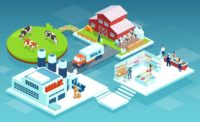
In the wake of COVID-19, industries worldwide faced unprecedented challenges, and the dairy sector was no exception. However, this industry’s response showcases a remarkable journey of resilience, innovation, and strategic adaptation, particularly regarding supply chain management. The dairy industry is navigating its post-pandemic recovery, focusing on the critical aspects of supply chain adjustments, technological advancements, and sustainability efforts.
Overcoming supply chain hurdles
The pandemic highlighted vulnerabilities in supply chains worldwide, and the dairy industry was at the forefront of feeling these impacts. Disruptions ranged from logistical bottlenecks to fluctuations in demand and supply imbalances. According to the “Dairy Industry Report” produced by PMMI, The Association for Packaging and Processing Technologies, dairy industry leaders quickly identified the need for more robust and flexible supply chain strategies. They emphasized diversification of suppliers, enhanced inventory management practices, and adopting more agile logistics solutions to mitigate future disruptions.
One of the key strategies has been the investment in technology to improve supply chain visibility. Advanced tracking systems, integrated software solutions, and data analytics have become instrumental in predicting disruptions, optimizing inventory levels, and ensuring a smooth flow of materials and finished products. This technological leap addresses the immediate challenges and lays a foundation for long-term efficiency and resilience in the dairy supply chain.
Embracing technological advancements
The PMMI report also sheds light on how the dairy industry leverages technology to enhance operational efficiencies. Automation in production processes has seen a significant uptick, driven by the need to reduce human contact and manage labor shortages. Robotics, artificial intelligence, and machine learning applications are streamlining operations from packaging to quality control, thereby increasing productivity and reducing costs.
Digitalization extends beyond the factory floor. Ecommerce and online platforms have become increasingly crucial for the dairy industry, providing alternative channels to reach consumers directly. This shift responds to changing consumer behaviors and offers dairy producers more control over their supply chains, allowing for more direct feedback and faster adjustments to market demands.
Sustainability and consumer preferences
Sustainability has become a critical focus area intertwined with supply chain management. The dairy industry is under growing pressure to reduce its environmental footprint, prompting a reevaluation of packaging materials, energy consumption, and waste management practices. PMMI’s report indicates a significant push toward eco-friendly packaging solutions, such as biodegradable materials and designs that minimize waste. These initiatives are environmentally responsible and resonate with the growing consumer demand for sustainable products.
Moreover, the industry is adapting to shifting consumer preferences toward health and wellness. The pandemic has heightened awareness around healthy eating, boosting demand for dairy products with added health benefits. This trend affects supply chain management as producers accelerate the introduction of new products and adjust their sourcing and distribution strategies to meet these evolving demands.
Looking ahead
The dairy industry’s post-COVID recovery is a testament to its ability to adapt and innovate in the face of adversity. The challenges brought on by the pandemic have accelerated overdue changes, pushing the industry toward more sustainable, efficient, and resilient supply chain practices. As highlighted in the PMMI report, the focus on technology, sustainability, and responding to consumer preferences will continue to shape the industry’s future.
The dairy sector’s journey through the pandemic and beyond is one of strategic adaptation and forward-thinking. By embracing technological advancements, enhancing supply chain resilience, and prioritizing sustainability and consumer needs, the industry is recovering and setting new standards for efficiency and responsibility. The lessons learned and the strategies implemented offer valuable insights for the dairy industry and global supply chains across sectors, underscoring the importance of adaptability, innovation, and sustainability in navigating the post-pandemic world.




